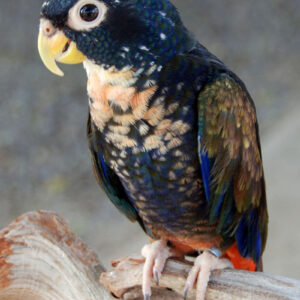Description
turquoise green cheek conures for sale
turquoise green cheek conures for sale near me
Origin and History
Turquoise Green Cheek Conure are native to South America with a range that extends from eastern Colombia to northern Argentina. Their preferred habitat includes savannah-like grasslands, woodlands, and forest margins. You will not find it in dense, humid forests. turquoise green cheek conures for sale near me
Temperament
Turquoise Green Cheek Conure conures are known for being intelligent birds full of playful energy. Like all parrots and conures, in particular, the blue-crowned conure needs a lot of mental stimulation and exercise to prevent it from becoming bored and restless.
These birds are very affectionate, social creatures. They bond strongly with the owner who treats them well and gives them the attention they crave. Blue-crowned conures rarely bite, which makes them a suitable pet for families with children.
Highly trainable, you can teach conures to retrieve items, turn around, and wave. The best strategy for successful training is ignoring bad behavior and rewarding good behavior with attention and treats.
However, there is no training that will turn this naturally noisy bird into a quiet one. If upset or excited, it can scream and shriek, which is not a good situation for apartment living. Attempts to scold the bird when it screams will only make it louder.
Speech and Vocalizations
Turquoise Green Cheek Conure conures are a bit quieter than other conure species, but no conure is a quiet bird. This species will be quite noisy in the morning and evening, which can create problems with close neighbors.
Turquoise Green Cheek Conure Colors and Markings
Males and females are identical in color and pattern. When born, the blue-crowned conure has a reddish head. It changes to bright blue by the time it reaches maturity. In addition to its signature parakeet green body and blue head, blue-crowned conures have reddish tips on their tail feathers, pink legs and feet, horn-colored beaks, and white rings around their eyes.
To tell a male apart from a female, use a genetic test. The physical difference is hardly noticeable, if at all. Males may have larger white eyepatches than females, and the feathers of their ceres (above their nostrils) tend to be longer.
Caring for the Turquoise Green Cheek Conure
This is not a bird you should plan to leave confined to a cage all of the time. The blue-crowned conure is a highly social bird that spends its time in a flock when in the wild. In captivity, you will need to serve the function of its flock mate.
If you are not around much during the day, a blue-crowned conure may be happier when it has another bird as a companion. It may also be happier if you leave a television or radio playing when the bird alone in the house.
Conures are unique parrots in that they like to snuggle underthings, such as a tightly woven washcloth, a soft piece of fabric, or a small blanket. It might even want a bird tent as a place to sleep.
In the wild, conures bathe daily. In captivity, they need a bath at least weekly, and more often if possible. Frequent bathing will keep the feathers and skin healthy. Wet your bird under a spray mist of lukewarm water; it counts as interaction time with your pet.
Common Health Issues
All conures can be prone to feather picking, which usually occurs because they are getting insufficient attention and stimulation. Spend time talking to your bird, train it tricks or learn to speak, and provide a rotating crop of toys to prevent your bird from getting bored.
The blue-crowned conure, like its cousins, is also susceptible to a variety of common bird diseases, including:
- Proventricular Dilatation Disease: a condition that can affect the nervous and digestive system
- Psittacine Beak and Feather Disease: an immunological disease affecting the beak, feathers, nails
- Psittacosis: a bacterial respiratory infection
- Aspergillosis: a fungal respiratory infection
Diet and Nutrition
In the wild, Turquoise Green Cheek Conure typically feast on a varied diet of fresh fruits, vegetables, nuts, berries, and grains.
Conures in captivity need an equally varied diet consisting of fresh fruits, vegetable greens, and high-quality pellets. Pellets should be about 75 percent of their diet. Offer about a 1/4 cup of pellets a day and watch how much your parrot consumes. Offer more if necessary. Most conures eat about 20 percent of their body weight. Pet conures fed a high-fat diet of only seeds and nuts often have health issues.
Offer fresh foods once or twice a day. Give them as much as they will eat. Remove the uneaten foods after the feeding period. Early morning is usually the most active meal time; these diurnal birds are generally hungry after a long night’s rest. You can also try feeding again right before dusk. Birds in the wild naturally forage for a final meal before they tuck in for the night.
As is the case with many birds, chocolate and avocado are toxic to conures.
Exercise
Turquoise Green Cheek Conure has a naturally high energy level. They prefer being out of the cage, interacting and talking with you throughout the day. Be prepared to give your bird at least 3 to 4 hours of supervised time out of the cage each day. Provide a freestanding play structure somewhere outside the cage for the bird to stretch its wings. During this period, give it the essential social interaction that it craves from you.
If you will not be releasing the bird from its its cage much, give it a spacious enclosure (36-by-36-by-36 inches) and fill it with toys that it can chew. Toys will help your bird get some exercise and stimulation. If you do not provide it with chewable toys, your conure might find less desirable items to chew, such as wires, furniture, and woodwork around the house.





